Biodegradable Electrospun Nanofiber Membranes as Promising Candidates for the Development of Face Masks
Abstract
1. Introduction
2. Basic Introductions to Air Filtration
2.1. Filtration Mechanism
- (1)
- (2)
- (3)
- Inertia effect. The inertia effect refers to a particle that cannot move along the original path, but is deposited on the fiber due to its inertia [28]. Therefore, the inertia effect would be much more obvious for a fast-moving aerosol particle [30]. Moreover, the strong inertia effect prefers a particle with a large size [31].
- (4)
- Diffusion effect. When tiny particles move along the streamline near the fiber, the irregular Brownian motion can enhance these particles to hit the fiber [28]. The particle diffusion distance can reach dozens of times larger than the fiber spacing, so the particles contact the fiber surface and deposition [32]. The diffusion effect is mainly reflected in the particles with small sizes. Moreover, low gas velocity can also result in predominant diffusion.
- (5)
- Electrostatic effect. The electrostatic effect can greatly improve filtration efficiency; however, the electrostatic effect is often neglected, unless the fibers or particles have been charged [26,33]. A neutral particle can be attracted to a charged fiber, and a charged particle can also be attracted to a neutral fiber. Moreover, because of the coulombic attraction, the electrostatic effect can work when the fiber and particle are oppositely charged.
2.2. Filtration Performance Index
2.2.1. Filtration Efficiency
2.2.2. Pressure Drop
2.2.3. Quality Factor
3. General Aspects of Face Masks
3.1. Cloth Mask
3.2. Surgical Mask
3.3. Respirator Mask
3.4. Functional Face Masks
3.4.1. Antibacterial
3.4.2. Biodegradability
3.4.3. Others
4. Nanofibers
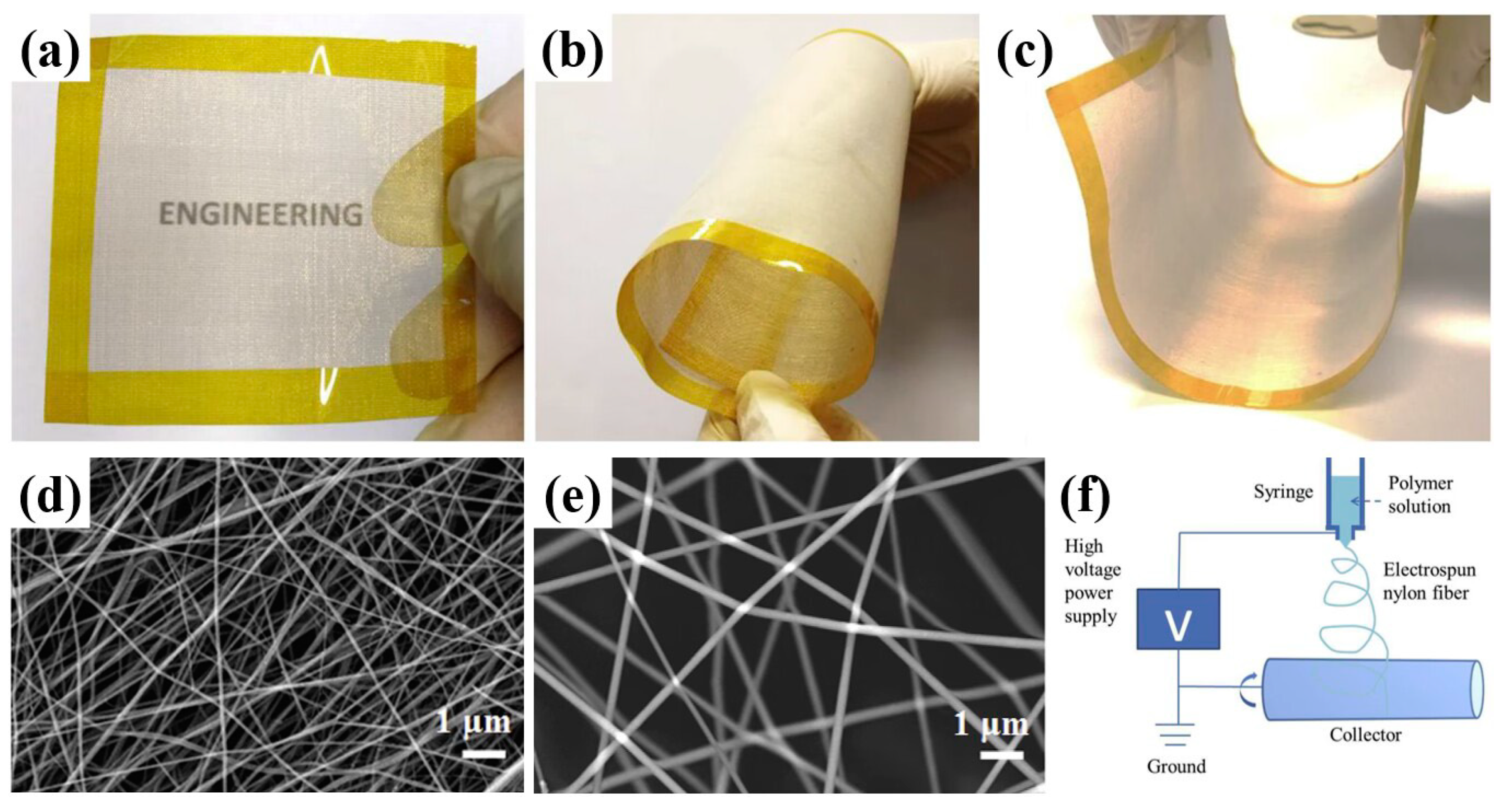
5. Biodegradable Nanofiber Filters
5.1. Silk Fibroin
5.2. PLA
5.3. Chitosan
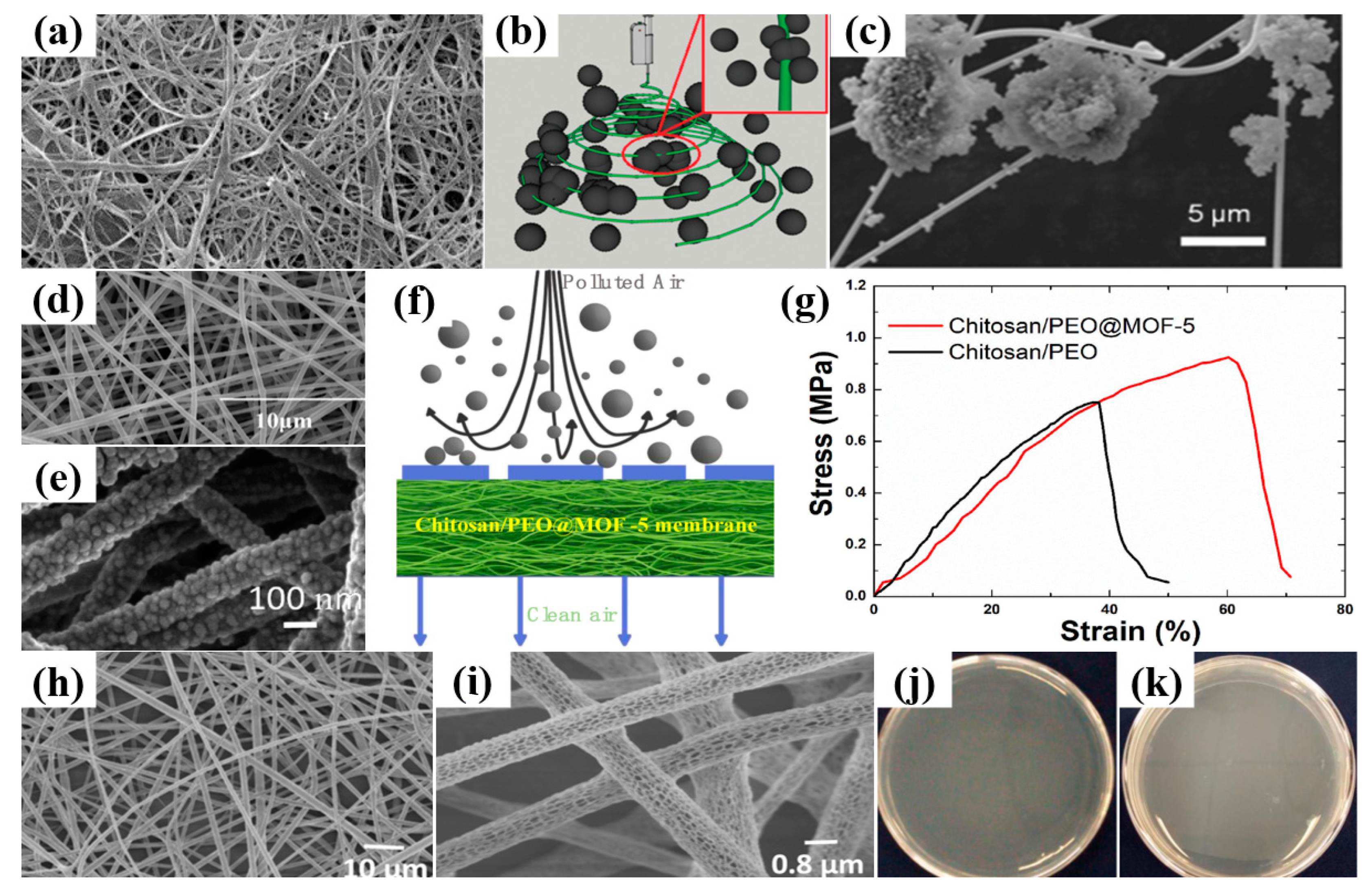
5.4. Cellulose
5.5. Zein
6. Conclusions
Author Contributions
Funding
Institutional Review Board Statement
Informed Consent Statement
Data Availability Statement
Conflicts of Interest
References
- Yan, E.; Lai, D.W.L.; Lee, V.W.P.; Ng, H.K.L. Predicting Public Adherence to COVID-19 Preventive Measures: A Cross-Sectional Study in Hong Kong. Int. J. Environ. Res. Public Health 2021, 18, 12403. [Google Scholar] [CrossRef] [PubMed]
- Cherrie, J.W.; Apsley, A.; Cowie, H.; Steinle, S.; Mueller, W.; Lin, C.; Horwell, C.J.; Sleeuwenhoek, A.; Loh, M. Effectiveness of face masks used to protect Beijing residents against particulate air pollution. Occup. Environ. Med. 2018, 75, 446–452. [Google Scholar] [CrossRef] [PubMed]
- Roberge, R.J.; Kim, J.-H.; Coca, A. Protective Facemask Impact on Human Thermoregulation: An Overview. Ann. Occup. Hyg. 2012, 56, 102–112. [Google Scholar] [CrossRef] [PubMed]
- Wang, C.C.; Prather, K.A.; Sznitman, J.; Jimenez, J.L.; Lakdawala, S.S.; Tufekci, Z.; Marr, L.C. Airborne transmission of respiratory viruses. Science 2021, 373, eabd9149. [Google Scholar] [CrossRef] [PubMed]
- Benson, N.U.; Bassey, D.E.; Palanisami, T. COVID pollution: Impact of COVID-19 pandemic on global plastic waste footprint. Heliyon 2021, 7, e06343. [Google Scholar] [CrossRef]
- Dissanayake, J.; Torres-Quiroz, C.; Mahato, J.; Park, J. Facemasks: A Looming Microplastic Crisis. Int. J. Environ. Res. Public Health 2021, 18, 7068. [Google Scholar] [CrossRef]
- Bian, Y.; Niu, Z.; Wang, S.; Pan, Y.; Zhang, L.; Chen, C. Removal of Size-Dependent Submicron Particles Using Metal-Organic Framework-Based Nanofiber Air Filters. Acs Appl. Mater. Interfaces 2022, 14, 23570–23576. [Google Scholar] [CrossRef]
- Niu, Z.; Bian, Y.; Xia, T.; Zhang, L.; Chen, C. An optimization approach for fabricating electrospun nanofiber air filters with minimized pressure drop for indoor PM2.5 control. Build. Environ. 2021, 188, 107449. [Google Scholar] [CrossRef]
- Wang, L.; Bian, Y.; Lim, C.K.; Niu, Z.; Lee, P.K.H.; Chen, C.; Zhang, L.; Daoud, W.A.; Zi, Y. Tribo-charge enhanced hybrid air filter masks for efficient particulate matter capture with greatly extended service life. Nano Energy 2021, 85, 106015. [Google Scholar] [CrossRef]
- Bian, Y.; Wang, R.; Wang, S.; Yao, C.; Ren, W.; Chen, C.; Zhang, L. Metal-organic framework-based nanofiber filters for effective indoor air quality control. J. Mater. Chem. A 2018, 6, 15807–15814. [Google Scholar] [CrossRef]
- Bian, Y.; Chen, C.; Wang, R.; Wang, S.; Pan, Y.; Zhao, B.; Chen, C.; Zhang, L. Effective removal of particles down to 15 nm using scalable metal-organic framework-based nanofiber filters. Appl. Mater. Today 2020, 20, 100653. [Google Scholar] [CrossRef]
- Deng, Y.; Lu, T.; Cui, J.; Samal, S.K.; Xiong, R.; Huang, C. Bio-based electrospun nanofiber as building blocks for a novel eco-friendly air filtration membrane: A review. Sep. Purif. Technol. 2021, 277, 119623. [Google Scholar] [CrossRef]
- He, P.W.; Wu, F.; Yang, M.; Jiao, W.L.; Yin, X.; Si, Y.; Yu, J.Y.; Ding, B. Green and antimicrobial 5-bromosalicylic acid/polyvinyl butyral nanofibrous membranes enable interception-sterilization-integrated bioprotection. Compos. Commun. 2021, 25, 100720. [Google Scholar] [CrossRef]
- Bian, Y.; Zhang, C.; Wang, H.; Cao, Q. Degradable nanofiber for eco-friendly air filtration: Progress and perspectives. Sep. Purif. Technol. 2023, 306, 122642. [Google Scholar] [CrossRef]
- Jalvandi, J.; White, M.; Gao, Y.; Truong, Y.B.; Padhye, R.; Kyratzis, I.L. Polyvinyl alcohol composite nanofibres containing conjugated levofloxacin-chitosan for controlled drug release. Mater. Sci. Eng. C-Mater. Biol. Appl. 2017, 73, 440–446. [Google Scholar] [CrossRef]
- Kadam, V.; Kyratzis, I.L.; Truong, Y.B.; Wang, L.J.; Padhye, R. Air filter media functionalized with beta-Cyclodextrin for efficient adsorption of volatile organic compounds. J. Appl. Polym. Sci. 2020, 137, 49228. [Google Scholar] [CrossRef]
- Truong, Y.B.; Glattauer, V.; Briggs, K.L.; Zappe, S.; Ramshaw, J.A.M. Collagen-based layer-by-layer coating on electrospun polymer scaffolds. Biomaterials 2012, 33, 9198–9204. [Google Scholar] [CrossRef]
- Sinha-Ray, S.; Zhang, Y.; Yarin, A.L.; Davis, S.C.; Pourdeyhimi, B. Solution Blowing of Soy Protein Fibers. Biomacromolecules 2011, 12, 2357–2363. [Google Scholar] [CrossRef]
- Song, W.; Zhang, M.; Huang, X.; Chen, B.; Ding, Y.; Zhang, Y.; Yu, D.G.; Kim, I. Smart l-borneol-loaded hierarchical hollow polymer nanospheres with antipollution and antibacterial capabilities. Mater. Today Chem. 2022, 26, 101252. [Google Scholar] [CrossRef]
- Khansari, S.; Duzyer, S.; Sinha-Ray, S.; Hockenberger, A.S.; Yarin, A.L.; Pourdeyhimi, B. Two-Stage Desorption-Controlled Release of Fluorescent Dye and Vitamin from Solution-Blown and Electrospun Nanofiber Mats Containing Porogens. Mol. Pharm. 2013, 10, 4509–4526. [Google Scholar] [CrossRef]
- Tang, Y.X.; Varyambath, A.; Ding, Y.C.; Chen, B.L.; Huang, X.Y.; Zhang, Y.; Yu, D.G.; Kim, I.; Song, W.L. Porous organic polymers for drug delivery: Hierarchical pore structures, variable morphologies, and biological properties. Biomater. Sci. 2022, 10, 5369–5390. [Google Scholar] [CrossRef] [PubMed]
- Sett, S.; Lee, M.W.; Weith, M.; Pourdeyhimi, B.; Yarin, A.L. Biodegradable and biocompatible soy protein/polymer/adhesive sticky nano-textured interfacial membranes for prevention of esca fungi invasion into pruning cuts and wounds of vines. J. Mater. Chem. B 2015, 3, 2147–2162. [Google Scholar] [CrossRef]
- Tien, C. Principles of Filtration; Elsevier: Amsterdam, The Netherlands, 2012; pp. 331–334. [Google Scholar]
- Pellegrino, J. Filtration and ultrafiltration equipment and techniques. Sep. Purif. Methods 2000, 29, 91–118. [Google Scholar] [CrossRef]
- Gao, Y.; Tian, E.; Zhang, Y.; Mo, J. Utilizing electrostatic effect in fibrous filters for efficient airborne particles removal: Principles, fabrication, and material properties. Appl. Mater. Today 2022, 26, 101369. [Google Scholar] [CrossRef]
- Tian, E.; Yu, Q.; Gao, Y.; Wang, H.; Wang, C.; Zhang, Y.; Li, B.; Zhu, M.; Mo, J.; Xu, G.; et al. Ultralow Resistance Two-Stage Electrostatically Assisted Air Filtration by Polydopamine Coated PET Coarse Filter. Small 2021, 17, 2102051. [Google Scholar] [CrossRef]
- Wang, Z.H.; Zhu, X.W.; Cheng, X.X.; Bai, L.M.; Luo, X.S.; Xu, D.L.; Ding, J.W.; Wang, J.L.; Li, G.B.; Shao, P.H.; et al. Nanofiltration Membranes with Octopus Arm-Sucker Surface Morphology: Filtration Performance and Mechanism Investigation. Environ. Sci. Technol. 2021, 55, 16676–16686. [Google Scholar] [CrossRef]
- Sabit, A. Wellington Sears Handbook of Industrial Textiles; Taylor and Francis; CRC Press: Boca Raton, FL, USA, 2017. [Google Scholar]
- Maduna, L.; Patnaik, A. Textiles in air filtration. Text. Prog. 2017, 49, 173–247. [Google Scholar] [CrossRef]
- Bandi, M.M. Electrocharged facepiece respirator fabrics using common materials. Proc. R. Soc. A-Math. Phys. Eng. Sci. 2020, 476, 20200469. [Google Scholar] [CrossRef]
- Stechkina, I.B.; Kirsch, A.A.; Fuchs, N.A. Studies on fibrous aerosol filters. IV. Calculation of aerosol deposition in model filters in the range of maximum penetration. Ann. Occup. Hyg. 1969, 12, 1–8. [Google Scholar]
- Lee, K.W.; Liu, B.Y.H. Theoretical-Study of Aerosol Filtration by Fibrous Filters. Aerosol Sci. Technol. 1982, 1, 147–161. [Google Scholar] [CrossRef]
- Gao, Y.; Tian, E.; Mo, J. Electrostatic Polydopamine-Interface-Mediated (e-PIM) filters with tuned surface topography and electrical properties for efficient particle capture and ozone removal. J. Hazard. Mater. 2023, 441, 129821. [Google Scholar] [CrossRef]
- Chen, R.; Zhang, K.; Wang, H.; Wang, X.M.; Zhang, X.H.; Huang, X. Incorporating catalytic ceramic membrane into the integrated process of in situ ozonation, membrane filtration and biological degradation: Enhanced performance and underlying mechanisms. J. Membr. Sci. 2022, 652, 120509. [Google Scholar] [CrossRef]
- Sanyal, A.; Sinha-Ray, S. Ultrafine PVDF Nanofibers for Filtration of Air-Borne Particulate Matters: A Comprehensive Review. Polymers 2021, 13, 1864. [Google Scholar] [CrossRef] [PubMed]
- Stanislas, T.T.; Bilba, K.; Santos, R.P.d.O.; Onesippe-Potiron, C.; Savastano Junior, H.; Arsene, M.-A. Nanocellulose-based membrane as a potential material for high performance biodegradable aerosol respirators for SARS-CoV-2 prevention: A review. Cellulose 2022, 29, 8001–8024. [Google Scholar] [CrossRef]
- Liu, H.; Cao, C.; Huang, J.; Chen, Z.; Chen, G.; Lai, Y. Progress on particulate matter filtration technology: Basic concepts, advanced materials, and performances. Nanoscale 2020, 12, 437–453. [Google Scholar] [CrossRef] [PubMed]
- Chen, X.; Yang, L.; Guo, J.; Xu, S.; Di, J.; Zhuang, J. Interactive removal of bacterial and viral particles during transport through low-cost filtering materials. Front. Microbiol. 2022, 13, 970338. [Google Scholar] [CrossRef] [PubMed]
- Zhou, J.; Hu, Z.; Zabihi, F.; Chen, Z.; Zhu, M. Progress and Perspective of Antiviral Protective Material. Adv. Fiber Mater. 2020, 2, 123–139. [Google Scholar] [CrossRef]
- Magee, M.; Lewis, C.; Noffs, G.; Reece, H.; Chan, J.C.S.; Zaga, C.J.; Paynter, C.; Birchall, O.; Azocar, S.R.; Ediriweera, A.; et al. Effects of face masks on acoustic analysis and speech perception: Implications for peri-pandemic protocols. J. Acoust. Soc. Am. 2020, 148, 3562–3568. [Google Scholar] [CrossRef]
- Konda, A.; Prakash, A.; Moss, G.A.; Schmoldt, M.; Grant, G.D.; Guha, S. Aerosol Filtration Efficiency of Common Fabrics Used in Respiratory Cloth Masks. Acs Nano 2020, 14, 6339–6347. [Google Scholar] [CrossRef]
- Howard, J.; Huang, A.; Li, Z.Y.; Tufekci, Z.; Zdimal, V.; van der Westhuizen, H.M.; von Delft, A.; Price, A.; Fridman, L.; Tang, L.H.; et al. An evidence review of face masks against COVID-19. Proc. Natl. Acad. Sci. USA 2021, 118, e2014564118. [Google Scholar] [CrossRef]
- Sharma, S.K.; Mishra, M.; Mudgal, S.K. Efficacy of cloth face mask in prevention of novel coronavirus infection transmission: A systematic review and meta-analysis. J. Educ. Health Promot. 2020, 9, 192. [Google Scholar] [CrossRef] [PubMed]
- Liao, M.R.; Liu, H.Y.; Wang, X.; Hu, X.Z.; Huang, Y.H.; Liu, X.Q.; Brenan, K.; Mecha, J.; Nirmalan, M.; Lu, J.R. A technical review of face mask wearing in preventing respiratory COVID-19 transmission. Curr. Opin. Colloid Interface Sci. 2021, 52, 101417. [Google Scholar] [CrossRef] [PubMed]
- Babaahmadi, V.; Amid, H.; Naeimirad, M.; Ramakrishna, S. Biodegradable and multifunctional surgical face masks: A brief review on demands during COVID-19 pandemic, recent developments, and future perspectives. Sci. Total Environ. 2021, 798, 149233. [Google Scholar] [CrossRef] [PubMed]
- Hao, W.; Parasch, A.; Williams, S.; Li, J.; Ma, H.; Burken, J.; Wang, Y. Filtration performances of non-medical materials as candidates for manufacturing facemasks and respirators. Int. J. Hyg. Environ. Health 2020, 229, 113582. [Google Scholar] [CrossRef]
- Rashid, T.U.; Sharmeen, S.; Biswas, S. Effectiveness of N95 Masks against SARS-CoV-2: Performance Efficiency, Concerns, and Future Directions. Acs Chem. Health Saf. 2022, 29, 135–164. [Google Scholar] [CrossRef]
- Weber, T.P.; Stilianakis, N.I. Inactivation of influenza A viruses in the environment and modes of transmission: A critical review. J. Infect. 2008, 57, 361–373. [Google Scholar] [CrossRef]
- Coulliette, A.D.; Perry, K.A.; Edwards, J.R.; Noble-Wang, J.A. Persistence of the 2009 Pandemic Influenza A (H1N1) Virus on N95 Respirators. Appl. Environ. Microbiol. 2013, 79, 2148–2155. [Google Scholar] [CrossRef]
- Hiragond, C.B.; Kshirsagar, A.S.; Dhapte, V.V.; Khanna, T.; Joshi, P.; More, P.V. Enhanced anti-microbial response of commercial face mask using colloidal silver nanoparticles. Vacuum 2018, 156, 475–482. [Google Scholar] [CrossRef]
- Gu, G.Q.; Han, C.B.; Lu, C.X.; He, C.; Jiang, T.; Gao, Z.L.; Li, C.J.; Wang, Z.L. Triboelectric Nanogenerator Enhanced Nanofiber Air Filters for Efficient Particulate Matter Removal. Acs Nano 2017, 11, 6211–6217. [Google Scholar] [CrossRef]
- Zhong, Z.X.; Xu, Z.; Sheng, T.; Yao, J.F.; Xing, W.H.; Wang, Y. Unusual Air Filters with Ultrahigh Efficiency and Antibacterial Functionality Enabled by ZnO Nanorods. Acs Appl. Mater. Interfaces 2015, 7, 21538–21544. [Google Scholar] [CrossRef]
- Lin, Z.; Wang, Z.; Zhang, X.; Diao, D. Superhydrophobic, photo-sterilize, and reusable mask based on graphene nanosheet-embedded carbon (GNEC) film. Nano Res. 2021, 14, 1110–1115. [Google Scholar] [CrossRef] [PubMed]
- Neisiany, R.E.; Enayati, M.S.; Kazemi-beydokhti, A.; Das, O.; Ramakrishna, S. Multilayered Bio-Based Electrospun Membranes: A Potential Porous Media for Filtration Applications. Front. Mater. 2020, 7, 67. [Google Scholar] [CrossRef]
- Yang, X.; Pu, Y.; Zhang, Y.; Liu, X.; Li, J.; Yuan, D.; Ning, X. Multifunctional composite membrane based on BaTiO3@PU/PSA nanofibers for high-efficiency PM2.5 removal. J. Hazard. Mater. 2020, 391, 122254. [Google Scholar] [CrossRef] [PubMed]
- Wang, C.; Meng, N.; Babar, A.A.; Gong, X.B.; Liu, G.H.; Wang, X.F.; Yu, J.Y.; Ding, B. Highly Transparent Nanofibrous Membranes Used as Transparent Masks for Efficient PM0.3 Removal. Acs Nano 2022, 16, 119–128. [Google Scholar] [CrossRef] [PubMed]
- Barhoum, A.; Pal, K.; Rahier, H.; Uludag, H.; Kim, I.S.; Bechelany, M. Nanofibers as new-generation materials: From spinning and nano-spinning fabrication techniques to emerging applications. Appl. Mater. Today 2019, 17, 1–35. [Google Scholar] [CrossRef]
- Huang, Z.M.; Zhang, Y.Z.; Kotaki, M.; Ramakrishna, S. A review on polymer nanofibers by electrospinning and their applications in nanocomposites. Compos. Sci. Technol. 2003, 63, 2223–2253. [Google Scholar] [CrossRef]
- Bian, Y.; Wang, S.; Jin, D.; Wang, R.; Chen, C.; Zhang, L. A general anion exchange strategy to transform metal-organic framework embedded nanofibers into high-performance lithium-ion capacitors. Nano Energy 2020, 75, 104935. [Google Scholar] [CrossRef]
- Nayak, R.; Padhye, R.; Kyratzis, I.; Truong, Y.B.; Arnold, L. Recent advances in nanofibre fabrication techniques. Text. Res. J. 2012, 82, 129–147. [Google Scholar] [CrossRef]
- Dong, H.; Strawhecker, K.E.; Snyder, J.F.; Orlicki, J.A.; Reiner, R.S.; Rudie, A.W. Cellulose nanocrystals as a reinforcing material for electrospun poly(methyl methacrylate) fibers: Formation, properties and nanomechanical characterization. Carbohydr. Polym. 2012, 87, 2488–2495. [Google Scholar] [CrossRef]
- Saba, N.; Paridah, M.T.; Abdan, K.; Ibrahim, N.A. A Review on Nano Fibre Technology in Polymer Composites. Pertanika J. Sci. Technol. 2017, 25, 1051–1072. [Google Scholar]
- Li, D.; McCann, J.T.; Xia, Y.N. Use of electrospinning to directly fabricate hollow nanofibers with functionalized inner and outer surfaces. Small 2005, 1, 83–86. [Google Scholar] [CrossRef] [PubMed]
- Ahmed, F.E.; Lalia, B.S.; Hashaikeh, R. A review on electrospinning for membrane fabrication: Challenges and applications. Desalination 2015, 356, 15–30. [Google Scholar] [CrossRef]
- Lu, T.; Deng, Y.; Cui, J.; Cao, W.; Qu, Q.; Wang, Y.; Xiong, R.; Ma, W.; Lei, J.; Huang, C. Multifunctional Applications of Blow-Spinning Setaria viridis Structured Fibrous Membranes in Water Purification. Acs Appl. Mater. Interfaces 2021, 13, 22874–22883. [Google Scholar] [CrossRef] [PubMed]
- Zhou, C.; Sun, Y.; Zhang, F.; Wu, Y. Degradation of Minocycline by the Adsorption-Catalysis Multifunctional PVDF-PVP-TiO2 Membrane: Degradation Kinetics, Photocatalytic Efficiency, and Toxicity of Products. Int. J. Environ. Res. Public Health 2021, 18, 12339. [Google Scholar] [CrossRef] [PubMed]
- Persano, L.; Camposeo, A.; Tekmen, C.; Pisignano, D. Industrial Upscaling of Electrospinning and Applications of Polymer Nanofibers: A Review. Macromol. Mater. Eng. 2013, 298, 504–520. [Google Scholar] [CrossRef]
- Han, W.; Rao, D.; Gao, H.; Yang, X.; Fan, H.; Li, C.; Dong, L.; Meng, H. Green-solvent-processable biodegradable poly(lactic acid) nanofibrous membranes with bead-on-string structure for effective air filtration: “Kill two birds with one stone”. Nano Energy 2022, 97, 107237. [Google Scholar] [CrossRef]
- Parham, S.; Kharazi, A.Z.; Bakhsheshi-Rad, H.R.; Ghayour, H.; Ismail, A.F.; Nur, H.; Berto, F. Electrospun Nano-Fibers for Biomedical and Tissue Engineering Applications: A Comprehensive Review. Materials 2020, 13, 2153. [Google Scholar] [CrossRef]
- Yoo, H.S.; Kim, T.G.; Park, T.G. Surface-functionalized electrospun nanofibers for tissue engineering and drug delivery. Adv. Drug Deliv. Rev. 2009, 61, 1033–1042. [Google Scholar] [CrossRef]
- Bian, Y.; Zhang, L.; Chen, C. Experimental and modeling study of pressure drop across electrospun nanofiber air filters. Build. Environ. 2018, 142, 244–251. [Google Scholar] [CrossRef]
- Bian, Y.; Wang, S.; Zhang, L.; Chen, C. Influence of fiber diameter, filter thickness, and packing density on PM2.5 removal efficiency of electrospun nanofiber air filters for indoor applications. Build. Environ. 2020, 170, 106628. [Google Scholar] [CrossRef]
- Shanmugam, V.; Babu, K.; Garrison, T.F.; Capezza, A.J.; Olsson, R.T.; Ramakrishna, S.; Hedenqvist, M.S.; Singha, S.; Bartoli, M.; Giorcelli, M.; et al. Potential natural polymer-based nanofibres for the development of facemasks in countering viral outbreaks. J. Appl. Polym. Sci. 2021, 138, 50658. [Google Scholar] [CrossRef] [PubMed]
- Huang, W.W.; Ling, S.J.; Li, C.M.; Omenetto, F.G.; Kaplan, D.L. Silkworm silk-based materials and devices generated using bio-nanotechnology. Chem. Soc. Rev. 2018, 47, 6486–6504. [Google Scholar] [CrossRef] [PubMed]
- Rockwood, D.N.; Preda, R.C.; Yucel, T.; Wang, X.Q.; Lovett, M.L.; Kaplan, D.L. Materials fabrication from Bombyx mori silk fibroin. Nat. Protoc. 2011, 6, 1612–1631. [Google Scholar] [CrossRef] [PubMed]
- Sun, W.; Gregory, D.A.; Tomeh, M.A.; Zhao, X. Silk Fibroin as a Functional Biomaterial for Tissue Engineering. Int. J. Mol. Sci. 2021, 22, 1499. [Google Scholar] [CrossRef]
- Woltje, M.; Kolbel, A.; Aibibu, D.; Cherif, C. A Fast and Reliable Process to Fabricate Regenerated Silk Fibroin Solution from Degummed Silk in 4 Hours. Int. J. Mol. Sci. 2021, 22, 10565. [Google Scholar] [CrossRef]
- Melke, J.; Midha, S.; Ghosh, S.; Ito, K.; Hofmann, S. Silk fibroin as biomaterial for bone tissue engineering. Acta Biomater. 2016, 31, 1–16. [Google Scholar] [CrossRef]
- Gao, X.C.; Gou, J.; Zhang, L.; Duan, S.S.; Li, C.Z. A silk fibroin based green nano-filter for air filtration. Rsc Adv. 2018, 8, 8181–8189. [Google Scholar] [CrossRef]
- Selvaraj, S.; Fathima, N.N. Fenugreek Incorporated Silk Fibroin Nanofibers-A Potential Antioxidant Scaffold for Enhanced Wound Healing. Acs Appl. Mater. Interfaces 2017, 9, 5916–5926. [Google Scholar] [CrossRef]
- Wang, Z.K.; Cui, Y.H.; Feng, Y.H.; Guan, L.; Dong, M.D.; Liu, Z.; Liu, L. A versatile Silk Fibroin based filtration membrane with enhanced mechanical property, disinfection and biodegradability. Chem. Eng. J. 2021, 426, 131947. [Google Scholar] [CrossRef]
- Wang, C.; Wu, S.; Jian, M.; Xie, J.; Xu, L.; Yang, X.; Zheng, Q.; Zhang, Y. Silk nanofibers as high efficient and lightweight air filter. Nano Res. 2016, 9, 2590–2597. [Google Scholar] [CrossRef]
- Bian, Y.; Wang, R.T.; Ting, S.H.; Chen, C.; Zhang, L. Electrospun SF/PVA Nanofiber Filters for Highly Efficient PM2.5 Capture. IEEE Trans. Nanotechnol. 2018, 17, 934–939. [Google Scholar] [CrossRef]
- Siskova, A.O.; Mosnackova, K.; Hruza, J.; Frajova, J.; Opalek, A.; Buckova, M.; Kozics, K.; Peer, P.; Andicsova, A.E. Electrospun Poly(ethylene Terephthalate)/Silk Fibroin Composite for Filtration Application. Polymers 2021, 13, 2499. [Google Scholar] [CrossRef] [PubMed]
- Wang, Z.; Song, X.; Cui, Y.; Cheng, K.; Tian, X.; Dong, M.; Liu, L. Silk fibroin H-fibroin/poly(epsilon-caprolactone) core-shell nanofibers with enhanced mechanical property and long-term drug release. J. Colloid Interface Sci. 2021, 593, 142–151. [Google Scholar] [CrossRef] [PubMed]
- Soo, X.Y.D.; Wang, S.; Yeo, C.C.J.; Li, J.; Ni, X.P.; Jiang, L.; Xue, K.; Li, Z.; Fei, X.; Zhu, Q.; et al. Polylactic acid face masks: Are these the sustainable solutions in times of COVID-19 pandemic? Sci. Total Environ. 2022, 807, 151084. [Google Scholar] [CrossRef] [PubMed]
- Mei, L.; Ren, Y.M.; Gu, Y.C.; Li, X.L.; Wang, C.; Du, Y.; Fan, R.R.; Gao, X.; Chen, H.F.; Tong, A.P.; et al. Strengthened and Thermally Resistant Poly(lactic acid)-Based Composite Nanofibers Prepared via Easy Stereocomplexation with Antibacterial Effects. Acs Appl. Mater. Interfaces 2018, 10, 42992–43002. [Google Scholar] [CrossRef] [PubMed]
- Lin, J.; Ding, B.; Yu, J.; Hsieh, Y. Direct Fabrication of Highly Nanoporous Polystyrene Fibers via Electrospinning. Acs Appl. Mater. Interfaces 2010, 2, 521–528. [Google Scholar] [CrossRef] [PubMed]
- Zuo, W.W.; Zhu, M.F.; Yang, W.; Yu, H.; Chen, Y.M.; Zhang, Y. Experimental study on relationship between jet instability and formation of beaded fibers during electrospinning. Polym. Eng. Sci. 2005, 45, 704–709. [Google Scholar] [CrossRef]
- Fong, H.; Chun, I.; Reneker, D.H. Beaded nanofibers formed during electrospinning. Polymer 1999, 40, 4585–4592. [Google Scholar] [CrossRef]
- Gupta, P.; Elkins, C.; Long, T.E.; Wilkes, G.L. Electrospinning of linear homopolymers of poly(methyl methacrylate): Exploring relationships between fiber formation, viscosity, molecular weight and concentration in a good solvent. Polymer 2005, 46, 4799–4810. [Google Scholar] [CrossRef]
- Wang, Z.; Zhao, C.C.; Pan, Z.J. Porous bead-on-string poly(lactic acid) fibrous membranes for air filtration. J. Colloid Interface Sci. 2015, 441, 121–129. [Google Scholar] [CrossRef]
- Wang, L.; Gao, Y.F.; Xiong, J.P.; Shao, W.L.; Cui, C.; Sun, N.; Zhang, Y.T.; Chang, S.Z.; Han, P.J.; Liu, F.; et al. Biodegradable and high-performance multiscale structured nanofiber membrane as mask filter media via poly(lactic acid) electrospinning. J. Colloid Interface Sci. 2022, 606, 961–970. [Google Scholar] [CrossRef] [PubMed]
- Raafat, D.; Leib, N.; Wilmes, M.; Francois, P.; Schrenzel, J.; Sahl, H.G. Development of in vitro resistance to chitosan is related to changes in cell envelope structure of Staphylococcus aureus. Carbohydr. Polym. 2017, 157, 146–155. [Google Scholar] [CrossRef]
- Sargazi, G.; Afzali, D.; Mostafavi, A.; Ebrahimipour, S.Y. Synthesis of CS/PVA Biodegradable Composite Nanofibers as a Microporous Material with Well Controllable Procedure Through Electrospinning. J. Polym. Environ. 2018, 26, 1804–1817. [Google Scholar] [CrossRef]
- Zhang, B.; Zhang, Z.G.; Yan, X.; Wang, X.X.; Zhao, H.; Guo, J.; Feng, J.Y.; Long, Y.Z. Chitosan nanostructures by in situ electrospinning for high-efficiency PM2.5 capture. Nanoscale 2017, 9, 4154–4161. [Google Scholar] [CrossRef] [PubMed]
- Dilamian, M.; Montazer, M.; Masoumi, J. Antimicrobial electrospun membranes of chitosan/poly(ethylene oxide) incorporating poly(hexamethylene biguanide) hydrochloride. Carbohydr. Polym. 2013, 94, 364–371. [Google Scholar] [CrossRef]
- Wang, C.; Fan, J.; Xu, R.; Zhang, L.; Zhong, S.; Wang, W.; Yu, D. Quaternary ammonium chitosan/polyvinyl alcohol composites prepared by electrospinning with high antibacterial properties and filtration efficiency. J. Mater. Sci. 2019, 54, 12522–12532. [Google Scholar] [CrossRef]
- Pan, W.; Wang, J.P.; Sun, X.B.; Wang, X.X.; Jiang, J.Y.; Zhang, Z.G.; Li, P.; Qu, C.H.; Long, Y.Z.; Yu, G.F. Ultra uniform metal-organic framework-5 loading along electrospun chitosan/polyethylene oxide membrane fibers for efficient PM2.5 removal. J. Clean. Prod. 2021, 291, 125270. [Google Scholar] [CrossRef]
- Li, H.; Wang, Z.; Zhang, H.Y.; Pan, Z.J. Nanoporous PLA/(Chitosan Nanoparticle) Composite Fibrous Membranes with Excellent Air Filtration and Antibacterial Performance. Polymers 2018, 10, 1085. [Google Scholar] [CrossRef]
- Croisier, F.; Jerome, C. Chitosan-based biomaterials for tissue engineering. Eur. Polym. J. 2013, 49, 780–792. [Google Scholar] [CrossRef]
- Sharma, S.; Batra, S. Chapter 5—Recent advances of chitosan composites in artificial skin: The next era for potential biomedical application. In Materials for Biomedical Engineering; Holban, A.-M., Grumezescu, A.M., Eds.; Elsevier: Amsterdam, The Netherlands, 2019; pp. 97–119. [Google Scholar]
- Ilyas, R.A.; Aisyah, H.A.; Nordin, A.; Ngadi, N.; Zuhri, M.Y.M.; Asyraf, M.R.M.; Sapuan, S.M.; Zainudin, E.S.; Sharma, S.; Abral, H.; et al. Natural-Fiber-Reinforced Chitosan, Chitosan Blends and Their Nanocomposites for Various Advanced Applications. Polymers 2022, 14, 874. [Google Scholar] [CrossRef]
- Min, B.M.; Lee, S.W.; Lim, J.N.; You, Y.; Lee, T.S.; Kang, P.H.; Park, W.H. Chitin and chitosan nanofibers: Electrospinning of chitin and deacetylation of chitin nanofibers. Polymer 2004, 45, 7137–7142. [Google Scholar] [CrossRef]
- Peng, B.L.; Yao, Z.L.; Wang, X.C.; Crombeen, M.; Sweeney, D.G.; Tam, K.C. Cellulose-based materials in wastewater treatment of petroleum industry. Green Energy Environ. 2020, 5, 37–49. [Google Scholar] [CrossRef]
- Alavi, M. Modifications of microcrystalline cellulose (MCC), nanofibrillated cellulose (NFC), and nanocrystalline cellulose (NCC) for antimicrobial and wound healing applications. E-Polymers 2019, 19, 103–119. [Google Scholar] [CrossRef]
- Stanislas, T.T.; Tendo, J.F.; Ojo, E.B.; Ngasoh, O.F.; Onwualu, P.A.; Njeugna, E.; Savastano, H. Production and Characterization of Pulp and Nanofibrillated Cellulose from Selected Tropical Plants. J. Nat. Fibers 2022, 19, 1592–1608. [Google Scholar] [CrossRef]
- Jiang, F.; Hsieh, Y.-L. Cellulose nanocrystal isolation from tomato peels and assembled nanofibers. Carbohydr. Polym. 2015, 122, 60–68. [Google Scholar] [CrossRef]
- Ma, Z.W.; Kotaki, M.; Ramakrishna, S. Electrospun cellulose nanofiber as affinity membrane. J. Membr. Sci. 2005, 265, 115–123. [Google Scholar] [CrossRef]
- Balgis, R.; Murata, H.; Goi, Y.; Ogi, T.; Okuyama, K.; Bao, L. Synthesis of Dual-Size Cellulose-Polyvinylpyrrolidone Nanofiber Composites via One-Step Electrospinning Method for High-Performance Air Filter. Langmuir 2017, 33, 6127–6134. [Google Scholar] [CrossRef]
- Sun, B.; Lin, J.; Liu, M.; Li, W.; Yang, L.; Zhang, L.; Chen, C.; Sun, D. In Situ Biosynthesis of Biodegradable Functional Bacterial Cellulose for High-Efficiency Particulate Air Filtration. Acs Sustain. Chem. Eng. 2022, 10, 1644–1652. [Google Scholar] [CrossRef]
- Hardian, R.; Alammar, A.; Holtzl, T.; Szekely, G. Fabrication of sustainable organic solvent nanofiltration membranes using cellulose-chitosan biopolymer blends. J. Membr. Sci. 2022, 658, 120743. [Google Scholar] [CrossRef]
- Gianazza, E.; Viglienghi, V.; Righetti, P.G.; Salamini, F.; Soave, C. Amino-Acid Composition of Zein Molecular Components. Phytochemistry 1977, 16, 315–317. [Google Scholar] [CrossRef]
- Khansari, S.; Sinha-Ray, S.; Yarin, A.L.; Pourdeyhimi, B. Biopolymer-Based Nanofiber Mats and Their Mechanical Characterization. Ind. Eng. Chem. Res. 2013, 52, 15104–15113. [Google Scholar] [CrossRef]
- Park, J.H.; Park, S.M.; Kim, Y.H.; Oh, W.; Lee, G.W.; Karim, M.R.; Park, J.H.; Yeum, J.H. Effect of montmorillonite on wettability and microstructure properties of zein/montmorillonite nanocomposite nanofiber mats. J. Compos. Mater. 2013, 47, 251–257. [Google Scholar] [CrossRef]
- Fan, X.; Wang, Y.; Zhong, W.H.; Pan, S.Y. Hierarchically Structured All-biomass Air Filters with High Filtration Efficiency and Low Air Pressure Drop Based on Pickering Emulsion. Acs Appl. Mater. Interfaces 2019, 11, 14266–14274. [Google Scholar] [CrossRef] [PubMed]
- Souzandeh, H.; Scudiero, L.; Wang, Y.; Zhong, W.-H. A Disposable Multi-Functional Air Filter: Paper Towel/Protein Nanofibers with Gradient Porous Structures for Capturing Pollutants of Broad Species and Sizes. Acs Sustain. Chem. Eng. 2017, 5, 6209–6217. [Google Scholar] [CrossRef]
- Tian, H.F.; Fu, X.W.; Zheng, M.; Wang, Y.; Li, Y.C.; Xiang, A.M.; Zhong, W.H. Natural polypeptides treat pollution complex: Moisture-resistant multi-functional protein nanofabrics for sustainable air filtration. Nano Res. 2018, 11, 4265–4277. [Google Scholar] [CrossRef]
- Yu, X.; Li, C.M.; Tian, H.F.; Yuan, L.; Xiang, A.M.; Li, J.L.; Wang, C.Y.; Rajulu, A.V. Hydrophobic cross-linked zein-based nanofibers with efficient air filtration and improved moisture stability. Chem. Eng. J. 2020, 396, 125373. [Google Scholar] [CrossRef]
- Hu, J.; Xiong, Z.J.; Liu, Y.Q.; Lin, J.Y. A biodegradable composite filter made from electrospun zein fibers underlaid on the cellulose paper towel. Int. J. Biol. Macromol. 2022, 204, 419–428. [Google Scholar] [CrossRef]
- Fan, X.; Wang, Y.; Zheng, M.; Dunne, F.; Liu, T.; Fu, X.W.; Kong, L.; Pan, S.Y.; Zhong, W.H. Morphology engineering of protein fabrics for advanced and sustainable filtration. J. Mater. Chem. A 2018, 6, 21585–21595. [Google Scholar] [CrossRef]
- Liu, J.J.; Dunne, F.O.; Fan, X.; Fu, X.W.; Zhong, W.H. A protein-functionalized microfiber/protein nanofiber Bi-layered air filter with synergistically enhanced filtration performance by a viable method. Sep. Purif. Technol. 2019, 229, 115837. [Google Scholar] [CrossRef]
- Fu, X.W.; Liu, J.J.; Ding, C.F.; Lin, S.N.; Zhong, W.H. Building bimodal structures by a wettability difference-driven strategy for high-performance protein air-filters. J. Hazard. Mater. 2021, 415, 125742. [Google Scholar] [CrossRef]
- Mosher, C.Z.; Brudnicki, P.A.P.; Gong, Z.X.; Childs, H.R.; Lee, S.W.; Antrobus, R.M.; Fang, E.C.; Schiros, T.N.; Lu, H.H. Green electrospinning for biomaterials and biofabrication. Biofabrication 2021, 13, 035049. [Google Scholar] [CrossRef] [PubMed]
- Castilla-Casadiego, D.A.; Maldonado, M.; Sundaram, P.; Almodovar, J. "Green" electrospinning of a collagen/hydroxyapatite composite nanofibrous scaffold. Mrs Commun. 2016, 6, 402–407. [Google Scholar] [CrossRef]
- Zakrzewska, A.; Bayan, M.A.H.; Nakielski, P.; Petronella, F.; De Sio, L.; Pierini, F. Nanotechnology Transition Roadmap toward Multifunctional Stimuli-Responsive Face Masks. Acs Appl. Mater. Interfaces 2022, 14, 46123–46144. [Google Scholar] [CrossRef]
- De Sio, L.; Ding, B.; Focsan, M.; Kogermann, K.; Pascoal-Faria, P.; Petronela, F.; Mitchell, G.; Zussman, E.; Pierini, F. Personalized Reusable Face Masks with Smart Nano-Assisted Destruction of Pathogens for COVID-19: A Visionary Road. Chem.-A Eur. J. 2021, 27, 6112–6130. [Google Scholar] [CrossRef]
- Le, T.T.; Curry, E.J.; Vinikoor, T.; Das, R.; Liu, Y.; Sheets, D.; Tran, K.T.M.; Hawxhurst, C.J.; Stevens, J.F.; Hancock, J.N.; et al. Piezoelectric Nanofiber Membrane for Reusable, Stable, and Highly Functional Face Mask Filter with Long-Term Biodegradability. Adv. Funct. Mater. 2022, 32, 2113040. [Google Scholar] [CrossRef]
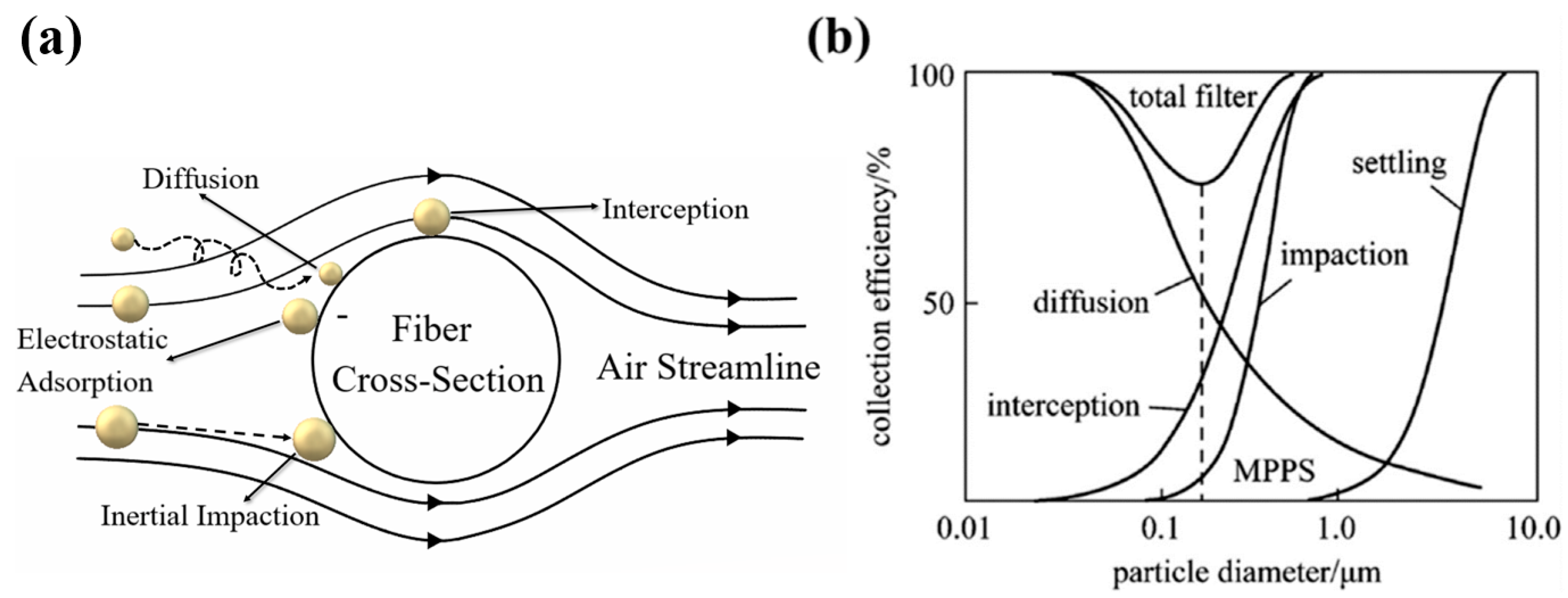
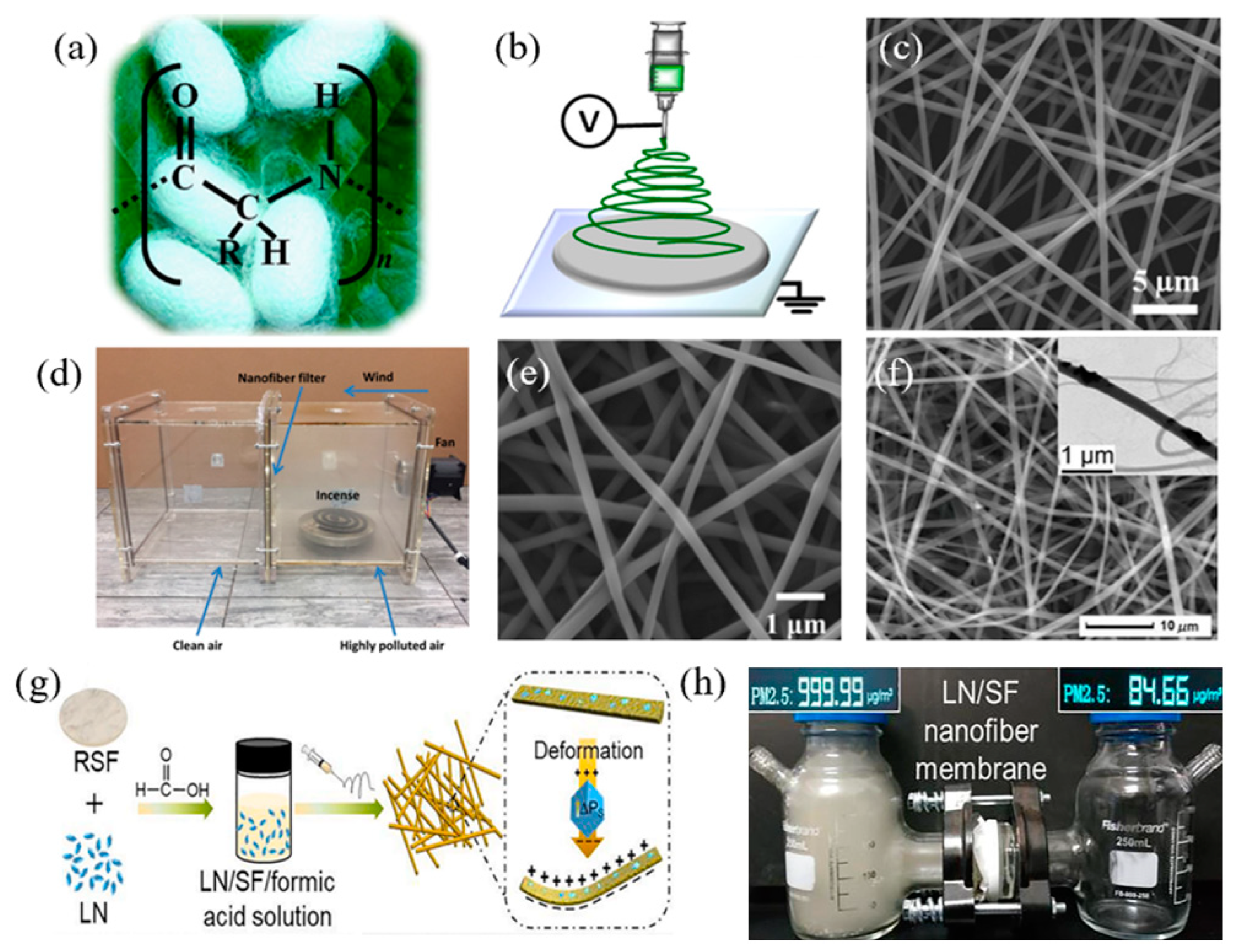
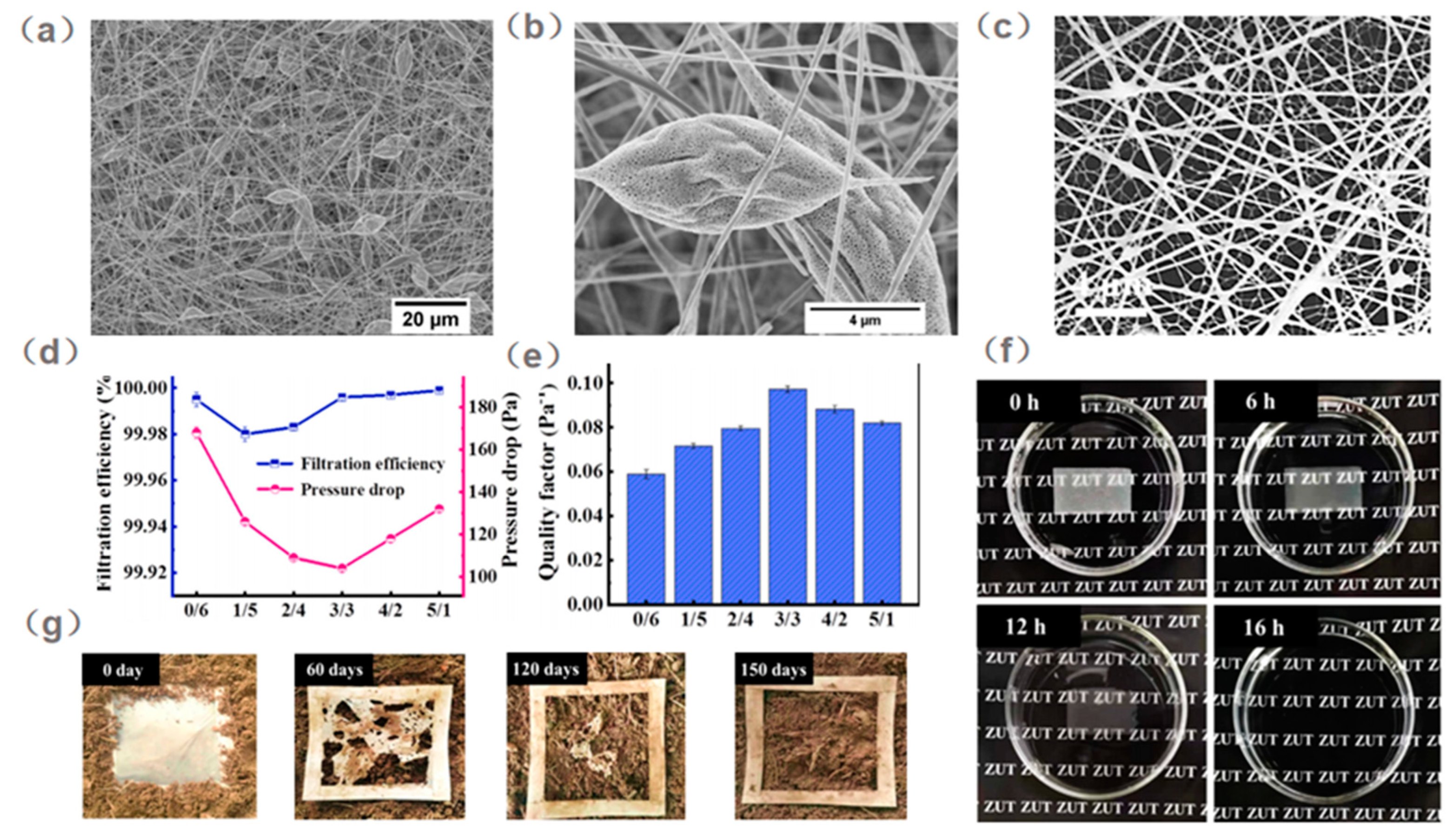
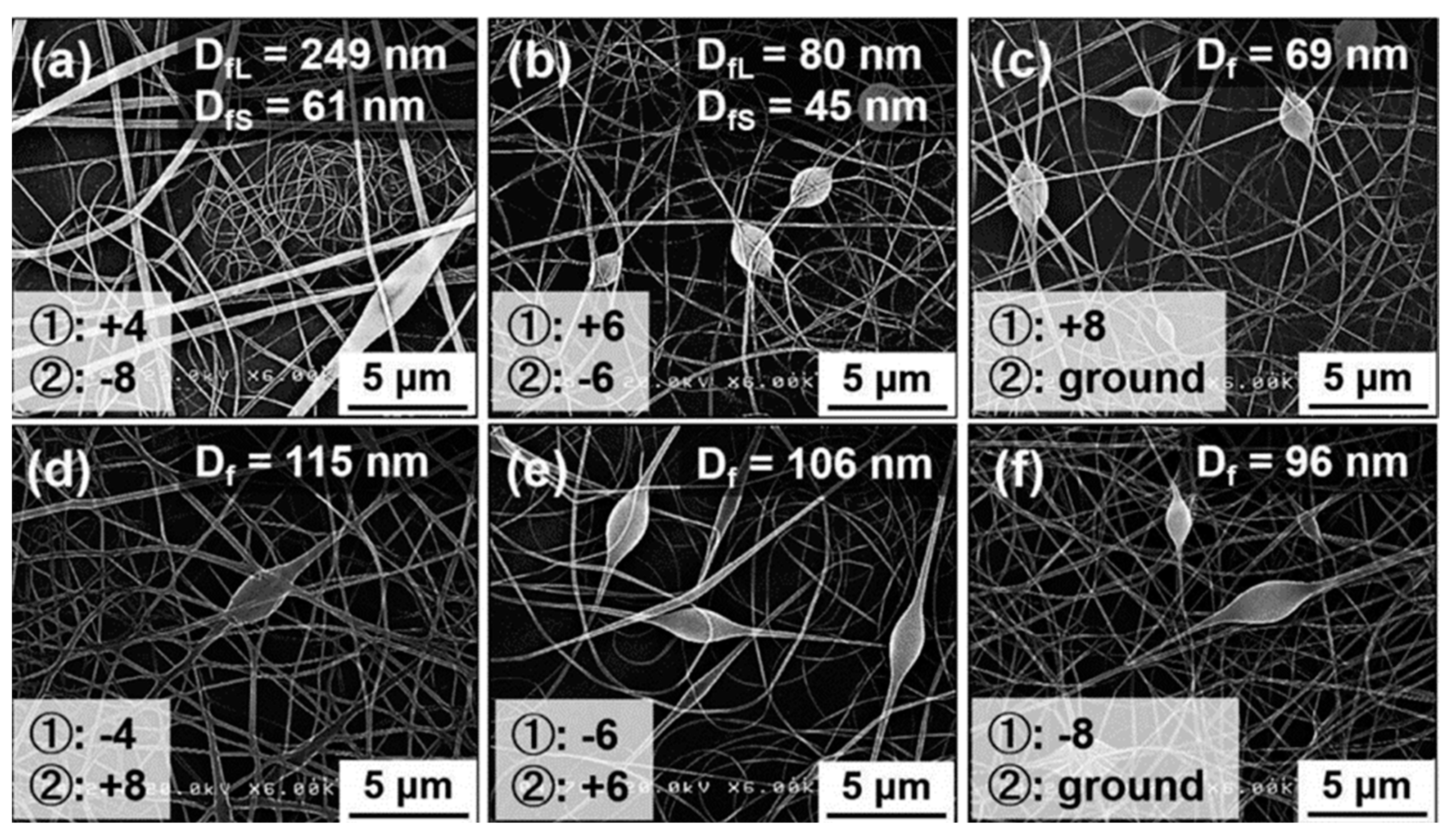

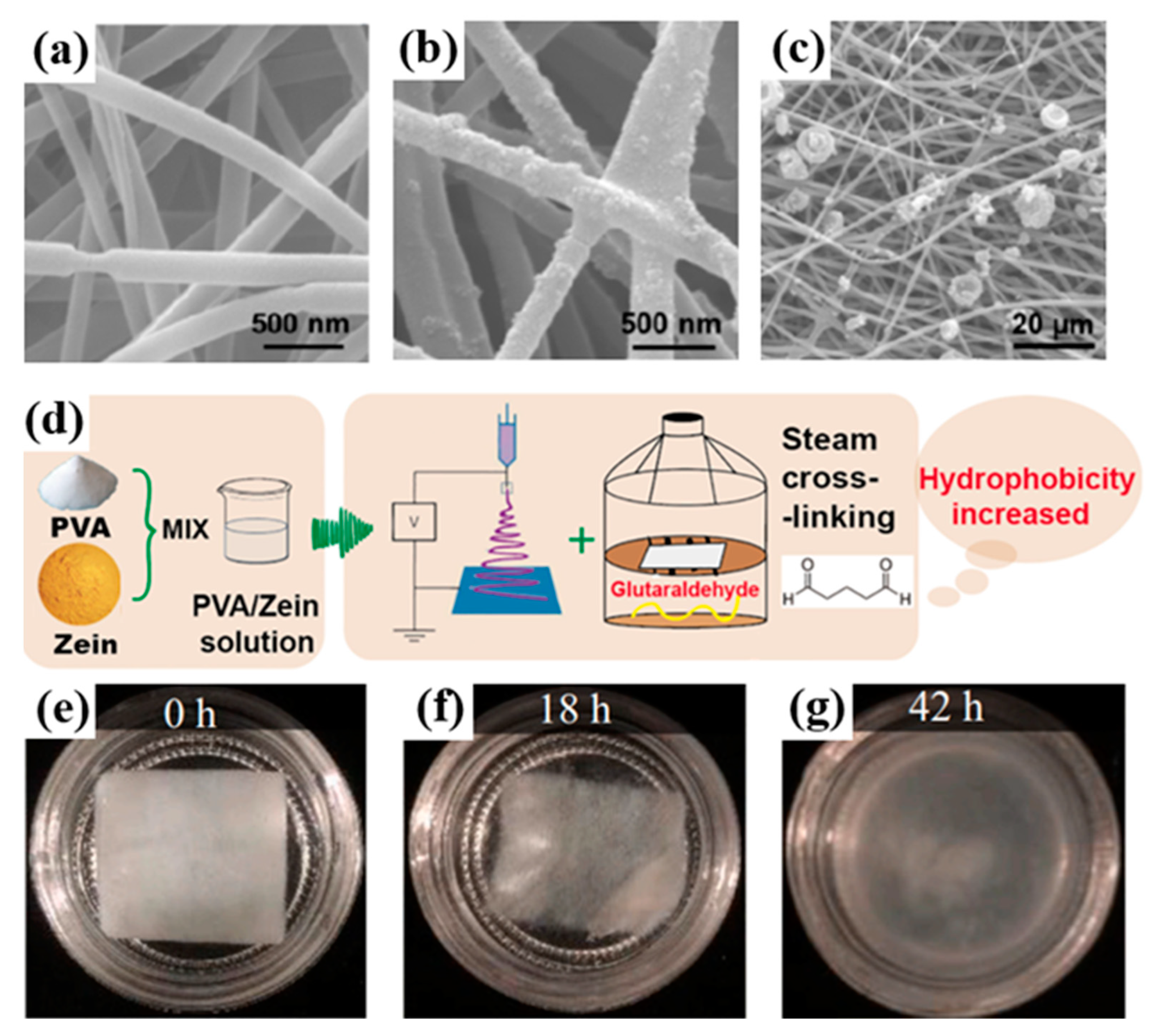

| Materials | PM/μm | Air Velocity | FE/% | Pressure Drop/Pa | QF/Pa−1 | Ref |
|---|---|---|---|---|---|---|
| LiNbO3/SF | 0.3–10 | 0.142 m/s | 98.1 | 102 | 0.039 | [81] |
| SF | 2.5 | 0.531 m/s | 98.8 | 98 | 0.045 | [82] |
| SF/PVA | 2.5 | 0.5 m/s | 99.11 | 50 | 0.094 | [83] |
| r-PET/SF | 0.12–2.46 | 0.053 m/s | 92.93 | 61.2 | 0.043 | [84] |
| PLA | 0.260 | 0.058 m/s | 99.997 | 165.3 | 0.064 | [92] |
| PLA | 2.5 | 32 L/min | 99.996 | 104 | 0.097 | [93] |
| Chitosan/PVA | 2.5 | 0.5 m/s | 86 | 52 | 0.038 | [98] |
| Chitosan/PEO | 2.5 | 99.95 | 44 | 0.0737 | [99] | |
| Chitosan/PLA | 0.3 | 0.014 m/s | 98.99 | 147.60 | 0.031 | [100] |
| Cellulose/PVP | 0.3–0.5 | 86.4 | 17 | 0.117 | [110] | |
| Cellulose | 0.3–10 | 0.02 m/s | 95 | 120 | 0.025 | [111] |
| Zein | 0.3–10 | 99.6 | 175 | 0.032 | [118] | |
| Zein | 0.3 | 0.0533 m/s | 99 | 109 | 0.042 | [120] |
| Zein/gelatin | 2.5 | 0.062 m/s | 99.67 | 38 | 0.150 | [123] |
Disclaimer/Publisher’s Note: The statements, opinions and data contained in all publications are solely those of the individual author(s) and contributor(s) and not of MDPI and/or the editor(s). MDPI and/or the editor(s) disclaim responsibility for any injury to people or property resulting from any ideas, methods, instructions or products referred to in the content. |
© 2023 by the authors. Licensee MDPI, Basel, Switzerland. This article is an open access article distributed under the terms and conditions of the Creative Commons Attribution (CC BY) license (https://creativecommons.org/licenses/by/4.0/).
Share and Cite
Shen, R.; Guo, Y.; Wang, S.; Tuerxun, A.; He, J.; Bian, Y. Biodegradable Electrospun Nanofiber Membranes as Promising Candidates for the Development of Face Masks. Int. J. Environ. Res. Public Health 2023, 20, 1306. https://doi.org/10.3390/ijerph20021306
Shen R, Guo Y, Wang S, Tuerxun A, He J, Bian Y. Biodegradable Electrospun Nanofiber Membranes as Promising Candidates for the Development of Face Masks. International Journal of Environmental Research and Public Health. 2023; 20(2):1306. https://doi.org/10.3390/ijerph20021306
Chicago/Turabian StyleShen, Rujun, Yunlong Guo, Shuaijie Wang, Ayikezi Tuerxun, Jiaqi He, and Ye Bian. 2023. "Biodegradable Electrospun Nanofiber Membranes as Promising Candidates for the Development of Face Masks" International Journal of Environmental Research and Public Health 20, no. 2: 1306. https://doi.org/10.3390/ijerph20021306
APA StyleShen, R., Guo, Y., Wang, S., Tuerxun, A., He, J., & Bian, Y. (2023). Biodegradable Electrospun Nanofiber Membranes as Promising Candidates for the Development of Face Masks. International Journal of Environmental Research and Public Health, 20(2), 1306. https://doi.org/10.3390/ijerph20021306






